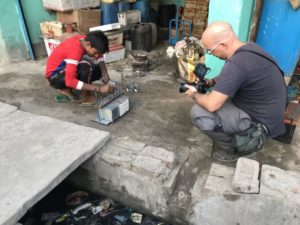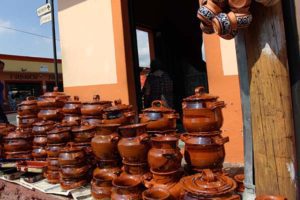
Facts About Lead Poisoning and Pollution:
- There is no known safe level of lead exposure.
- The CDC lowered the level of concern from 10 to 5 µg/dL (micrograms /deciliter) as the point at which to trigger public health actions.
- In the U.S., about 500,000 U.S. children are estimated to have a blood lead level of at least 5 µg/dL.
- Average blood lead level in the U.S. is 1.8 µg/dL. In some of the world’s worst polluted places, we have found levels as high as 234 µg/dL in children.
- Childhood lead exposure is estimated to contribute to 600,000 new cases globally of children with intellectual disabilities every year.
- Lead exposure is estimated to account for 143, 000 deaths per year, or 0.6% of the global burden of disease, with the highest burden in developing regions.
- In a review of 242 studies of known chemically contaminated sites, lead was the primary contaminant in 57 (25%) studies, representing 8,345 exposed children.
- Lead is the most common pollutant identified in the Pure Earth database of global polluted sites. Pure Earth has conducted more than 1,000 field assessments of sites contaminated with lead. One example, investigators for Pure Earth’s Toxic Sites Identification Program typically aim to identify and assess 20-30 contaminated sites per year in a given country. In Bangladesh and India alone, the teams were able to identify and assess 166 sites where the health of local residents was at risk due to lead pollution in six months.
- Lead has been identified as one of the top six toxic threats.
- Lead poisoning can be treated and lead levels lowered, but damage caused from childhood lead poisoning is irreversible and permanent.
- Lead exposure is entirely preventable.
-
Lead exposure often occurs with no obvious symptoms as lead accumulates in the body over time. Lead poisoning therefore frequently goes unrecognized.
Lead Poisoning Health Effects:
- Lead is a potent neurotoxin, causing lower intellectual capacity, neurological damage, and cardiovascular disease, amongst other problems.
- Children are the most vulnerable. Lead can affect nearly every system in a young developing body, in particular the brain and nervous system, with devastating and sometimes permanent health consequences.
- The presence of lead in children lowers I.Q. by an estimated 4-7 points for each increase of 10 μg/dL.
- A recent study by Dr. Bruce Lanphear has further demonstrated that lead causes adult mortality from an increase in heart attacks and stroke.
- In adults, lead poisoning can also lead to increased risk of high blood pressure and kidney damage. In pregnant women, lead poisoning can cause miscarriage and stillbirths.
Sources of Lead Poisoning and Pollution:

Improper recycling of used lead-acid batteries: Some experts believe that the improper recycling of used lead-acid (car) batteries is one of the top childhood environmental health threat globally. Of the six million tons of lead that are used annually, approximately three quarters go into the production of lead-acid batteries. Of these batteries, 97% are eventually recycled to retrieve the lead.
The informal recycling of used lead-acid batteries happens in every city in the developing world, often in small mom-and-pop operations with little or no regulations. Batteries are broken up by hand, often in backyards, and sometimes smelted in kitchens with children nearby.
Each lead-acid battery contains about 20 lbs of lead. The lead found in only 9 automobile batteries is enough to contaminate a standard size soccer field to a depth of 1 inch (2.5 cm) at the US EPA level of 400 ppm.

Traditional lead-glazed pottery: The national lead poisoning problem in Mexico can be traced to a 500-year old tradition of using lead-based glazes in pottery that is used to cook and serve food in many of the country’s homes and restaurants. (Fact Sheet: Mexico’s 500-year-old problem). This problem is not limited to Mexico. Other countries like Brazil also produce leaded pottery.
Other sources include mining, smelting, manufacturing and the continued use of leaded paint and leaded gasoline in some countries.
Examples of Lead Cleanups and Solutions Around The World:
- In Armenia, a Pure Earth cleanup brought the toxic legacy at a 10th Century Armenian site to an end. The lead levels found at the historic Apostolic church and monastery in Akhtala were the highest not only in the country, but possibly the world. The lead contamination had roots in the site’s history as a fortress in the 10th century, where metal works and weapon making took place on the grounds. Later, mining in the region deposited more polluted waste.
- In Bangladesh, children’s lead levels fell 42% following a Pure Earth cleanup in Kathgora.
- In Colombia, Pure Earth cleaned up the community of Malambo, and also replaced lead-contaminated mattresses for about 100 children. A pair of siblings–Hilary, age 2, and Juan, age 4–were sharing a mattress that contained over 1300 ppm (parts per million) of lead, while three year-old Liz’s mattress measured 928 ppm of lead.
- In Haina in the Dominican Republic, a hotspot of lead contamination because of improper battery recycling, blood lead levels were as high as 234µg/dL. (God’s Paradise Starts to Shed World’s Worst Polluted Label)
- In Indonesia, a playground near the primary school in Cinangka was so toxic that parts of the field had lead levels that measured 123 times above the (WHO) standard. Pure Earth’s cleanup transformed a soccer field for children who were wishing for a safe soccer field.
- In India, about 300 children in Karmalichak lived with toxic lead. Many were poisoned in school. An informal battery manufacturer (now closed) was assembling batteries less than 10 meters from a school attended by 250 children. 41 local children tested had mean blood lead levels of approximately 25 μg/dL, with some recording blood lead levels as high as 80 μg/dL—16 times the US CDC’s reference level. Pure Earth cleaned up the neighborhood and helped to organize a community gathering to educate the community about the dangers of lead.
- In Sovetskoe (Kan), Kyrgyzstan, Pure Earth cleaned up a town filled with piles of contaminated red sand.
- In Mexico, where many of the country’s 50,000 potters use toxic lead-based glazes, the average blood lead levels for children and their families in artisan communities is 26 to 40 µg/dL. Nationally, up to 20% of the population have high lead levels from the use of traditional leaded pottery in homes and restaurants. Pure Earth is training potters to switch to lead-free glazes, and to promote the use of lead-free pottery. Read the story of Baby X in Mexico.
- In Nigeria, the high price of gold prompted a mini gold rush in 2010, and villagers took to mining the lead-rich ore. This resulted in the world’s worst outbreak of lead poisoning. Over 400 children were killed. Lead levels as high as 150µg/dL were recorded. (see Photos)
- In Senegal in 2009, a lead poisoning outbreak went undetected until 18 children died. The highest lead levels recorded in children between one and five years-old was 158 µg/dL. One woman, who recycled batteries by hand, lost five children to lead poisoning before she began to suspect her job was the source of the lead contamination. One by one, each of her five youngest children fell ill with the same symptoms — seizures and convulsions. One by one, they perished the same way, before the age of two. (Read her story)
- In Vietnam, toxic craft villages left a damaging legacy, which Pure Earth cleaned up. Watch the VIDEO: Toxic “craft” village cleans up.
- In Kabwe, Zambia, Pure Earth found children with severely high blood lead levels. In fact, nearly 100% of children in the neighborhood were poisoned. In 2015, Pure Earth’s cleanup work in Chowa, Kabwe, freed residents from dangerous lead exposure in their homes and yards for the first time in 100 years. The cleanup was featured on the front page of The Guardian newspaper (The world’s most toxic town: the terrible legacy of Zambia’s lead mines) and also on NPR (What Does Flint, Michigan, And Kabwe, Zambia, Have In Common? and Whatever Happened To … The Kids Whose Lead Levels Were Off The Charts?
Global Lead Program
Pure Earth’s Global Lead Program has proven effective in addressing lead contamination. The program’s strategy includes:
- Rapid Environmental And Health Risk Assessments
- Site Prioritization And Project Selection
- Detailed Environmental And Health Risk Assessments
- Conceptual Site Modeling
- Alternative Remediation Analysis
- Remediation
Learn more:
- Pure Earth’s Global Lead Program
- CDC
- WHO
- Lead page on www.worstpolluted.org
- Notes from the Field: Severe Environmental Contamination and Elevated Blood Lead Levels Among Children in Zambia, Morbidity and Mortality Weekly Report (MMWR), Nov. 7, 2014
- The burden of disease from pediatric lead exposure at hazardous waste sites in 7 Asian countries (2013, Environmental Research)





